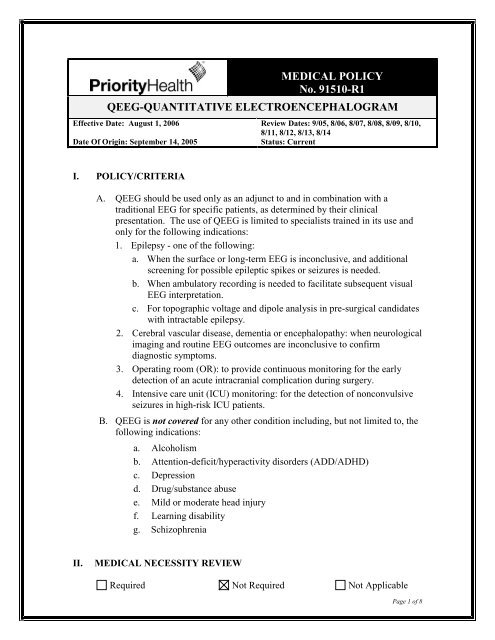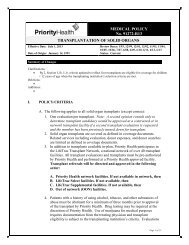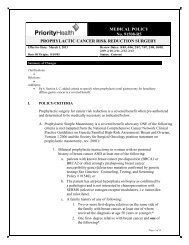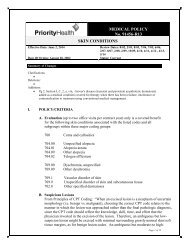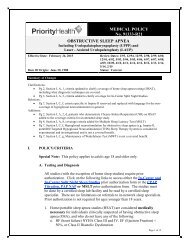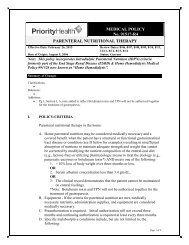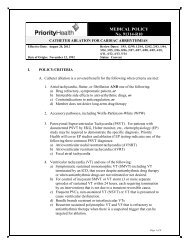QEEG-Quantitative Electroencephalogram - Priority Health
QEEG-Quantitative Electroencephalogram - Priority Health
QEEG-Quantitative Electroencephalogram - Priority Health
Create successful ePaper yourself
Turn your PDF publications into a flip-book with our unique Google optimized e-Paper software.
MEDICAL POLICY<br />
No. 91510-R1<br />
<strong>QEEG</strong>-QUANTITATIVE ELECTROENCEPHALOGRAM<br />
Effective Date: August 1, 2006 Review Dates: 9/05, 8/06, 8/07, 8/08, 8/09, 8/10,<br />
8/11, 8/12, 8/13, 8/14<br />
Date Of Origin: September 14, 2005<br />
Status: Current<br />
I. POLICY/CRITERIA<br />
A. <strong>QEEG</strong> should be used only as an adjunct to and in combination with a<br />
traditional EEG for specific patients, as determined by their clinical<br />
presentation. The use of <strong>QEEG</strong> is limited to specialists trained in its use and<br />
only for the following indications:<br />
1. Epilepsy - one of the following:<br />
a. When the surface or long-term EEG is inconclusive, and additional<br />
screening for possible epileptic spikes or seizures is needed.<br />
b. When ambulatory recording is needed to facilitate subsequent visual<br />
EEG interpretation.<br />
c. For topographic voltage and dipole analysis in pre-surgical candidates<br />
with intractable epilepsy.<br />
2. Cerebral vascular disease, dementia or encephalopathy: when neurological<br />
imaging and routine EEG outcomes are inconclusive to confirm<br />
diagnostic symptoms.<br />
3. Operating room (OR): to provide continuous monitoring for the early<br />
detection of an acute intracranial complication during surgery.<br />
4. Intensive care unit (ICU) monitoring: for the detection of nonconvulsive<br />
seizures in high-risk ICU patients.<br />
B. <strong>QEEG</strong> is not covered for any other condition including, but not limited to, the<br />
following indications:<br />
a. Alcoholism<br />
b. Attention-deficit/hyperactivity disorders (ADD/ADHD)<br />
c. Depression<br />
d. Drug/substance abuse<br />
e. Mild or moderate head injury<br />
f. Learning disability<br />
g. Schizophrenia<br />
II.<br />
MEDICAL NECESSITY REVIEW<br />
Required Not Required Not Applicable<br />
Page 1 of 8
MEDICAL POLICY<br />
No. 91510-R1<br />
<strong>QEEG</strong><br />
III. APPLICATION TO PRODUCTS<br />
Coverage is subject to member’s specific benefits. Group specific policy will<br />
supersede this policy when applicable.<br />
HMO/EPO: This policy applies to insured HMO/EPO plans.<br />
POS: This policy applies to insured POS plans.<br />
PPO: This policy applies to insured PPO plans. Consult individual plan documents as state<br />
mandated benefits may apply. If there is a conflict between this policy and a plan document,<br />
the provisions of the plan document will govern.<br />
ASO: For self-funded plans, consult individual plan documents. If there is a conflict<br />
between this policy and a self-funded plan document, the provisions of the plan document will<br />
govern.<br />
INDIVIDUAL: For individual policies, consult the individual insurance policy. If there is a<br />
conflict between this medical policy and the individual insurance policy document, the<br />
provisions of the individual insurance policy will govern.<br />
MEDICARE: Coverage is determined by the Centers for Medicare and Medicaid Services<br />
(CMS); if a coverage determination has not been adopted by CMS, this policy applies.<br />
MEDICAID/HEALTHY MICHIGAN PLAN: For Medicaid/<strong>Health</strong>y Michigan Plan<br />
members, this policy will apply. Coverage is based on medical necessity criteria being met and<br />
the appropriate code(s) from the coding section of this policy being included on the Michigan<br />
Medicaid Fee Schedule located at: http://www.michigan.gov/mdch/0,1607,7-132-<br />
2945_42542_42543_42546_42551-159815--,00.html. If there is a discrepancy between this<br />
policy and the Michigan Medicaid Provider Manual located at:<br />
http://www.michigan.gov/mdch/0,1607,7-132-2945_5100-87572--,00.html, the Michigan<br />
Medicaid Provider Manual will govern. For Medical Supplies/DME/Prosthetics and<br />
Orthotics, please refer to the Michigan Medicaid Fee Schedule to verify coverage.<br />
MICHILD: For MICHILD members, this policy will apply unless MICHILD certificate of<br />
coverage limits or extends coverage.<br />
IV. DESCRIPTION<br />
<strong>Quantitative</strong> electroencephalogram (<strong>QEEG</strong>) or brain electrical activity mapping<br />
(BEAM) is a visual enhancement of a traditional surface EEG. The process<br />
transforms the surface EEG data into a topographic display of brain / seizure<br />
activity. The images are placed on a schematic map of the brain and the activity<br />
data is analyzed by size of the activity spike, frequency and location. This data is<br />
then compared to a database of normal patient brainwaves to determine specific<br />
seizure type, location and possible underlying medical condition. <strong>QEEG</strong> is noninvasive<br />
and can be used on all age groups but requires the interpretation of a<br />
specialist trained in quantitative encephalographic analysis.<br />
V. CODING INFORMATION<br />
ICD-9 Codes that may support medical necessity (for dates of service on or before<br />
September 30, 2015):<br />
290.0 – 290.9 Dementia<br />
Page 2 of 8
MEDICAL POLICY<br />
No. 91510-R1<br />
<strong>QEEG</strong><br />
294.10 Dementia in conditions classified elsewhere without behavioral<br />
disturbance<br />
294.11 Dementia in conditions classified elsewhere with behavioral<br />
disturbance<br />
331.0 Alzheimer's disease<br />
331.11 Pick's disease<br />
331.19 Other frontotemporal dementia<br />
331.2 Senile degeneration of brain<br />
331.7 Cerebral degeneration in diseases classified elsewhere<br />
331.81 – 331.89 Other cerebral degeneration<br />
331.9 Unspecified cerebral degeneration<br />
345.00 Generalized nonconvulsive epilepsy<br />
345.01 Generalized nonconvulsive epilepsy with intractable epilepsy<br />
345.10 Generalized convulsive epilepsy without mention of intractable<br />
epilepsy<br />
345.11 Generalized convulsive epilepsy with intractable epilepsy<br />
348.30 Encephalopathy, unspecified<br />
348.31 Metabolic encephalopathy<br />
348.39 Other encephalopathy<br />
434.00 Thrombosis of cerebral arteries, without mention of cerebral<br />
infarction<br />
434.01 Thrombosis of cerebral arteries, with cerebral infarction<br />
434.10 Cerebral embolism, without mention of cerebral infarction<br />
434.11 Cerebral embolism, with cerebral infarction<br />
434.90 Cerebral artery occlusion, without mention of cerebral infarction<br />
434.91 Cerebral artery occlusion, with cerebral infarction<br />
436 Acute, but ill-defined, cerebrovascular disease<br />
437.1 Other generalized ischemic cerebrovascular disease<br />
437.8 Other ill-defined cerebrovascular disease<br />
437.9 Unspecified cerebrovascular disease<br />
438.0 Cognitive deficits due to cerebrovascular disease<br />
780.01 Coma<br />
780.03 Persistent vegetative state<br />
780.09 Other alteration of consciousness<br />
ICD-10 Codes that may support medical necessity (for dates of service on or after October<br />
1, 2015):<br />
E03.5 Myxedema coma<br />
F01.50 Vascular dementia without behavioral disturbance<br />
F01.51 Vascular dementia with behavioral disturbance<br />
F02.80 – F02.81 Dementia in other diseases<br />
F03.90 Unspecified dementia without behavioral disturbance<br />
F05<br />
Delirium due to known physiological condition<br />
G13.2 Systemic atrophy primarily affecting the central nervous system in<br />
myxedema<br />
G13.8 Systemic atrophy primarily affecting central nervous system in<br />
other diseases classified elsewhere<br />
G30.0 – G30.9 Alzheimer's disease<br />
Page 3 of 8
MEDICAL POLICY<br />
No. 91510-R1<br />
<strong>QEEG</strong><br />
G31.01 – G31.9 Other degenerative diseases of nervous system, not elsewhere<br />
classified<br />
G40.301 - G40.411 Generalized idiopathic epilepsy and epileptic syndromes<br />
G46.4 Cerebellar stroke syndrome<br />
G46.5 Pure motor lacunar syndrome<br />
G46.6 Pure sensory lacunar syndrome<br />
G46.7 Other lacunar syndromes<br />
G46.8 Other vascular syndromes of brain in cerebrovascular diseases<br />
G91.4 Hydrocephalus in diseases classified elsewhere<br />
G93.40 – G93.49 Other encephalopathy<br />
G93.7 Reye's syndrome<br />
G94<br />
Other disorders of brain in diseases classified elsewhere<br />
I63.30 - I63.9 Cerebral infarction<br />
I66.01 – I66.9 Occlusion and stenosis of cerebral arteries,<br />
I68.0 Cerebral amyloid angiopathy<br />
I68.8 Other cerebrovascular disorders in diseases classified elsewhere<br />
I69.01 Cognitive deficits following nontraumatic subarachnoid<br />
hemorrhage<br />
I69.11 Cognitive deficits following nontraumatic intracerebral hemorrhage<br />
I69.21 Cognitive deficits following other nontraumatic intracranial<br />
hemorrhage<br />
I69.31 Cognitive deficits following cerebral infarction<br />
I69.81 Cognitive deficits following other cerebrovascular disease<br />
I69.91 Cognitive deficits following unspecified cerebrovascular disease<br />
R40.0 Somnolence<br />
R40.1 Stupor<br />
R40.20 - R40.3 Coma<br />
ICD-9 Codes that do NOT support medical necessity (for dates of service on or before<br />
September 30, 2015):<br />
This list should not be considered inclusive:<br />
291.0 – 291.5 Alcohol-induced mental disorders<br />
291.81 – 291.89 Other specified alcohol-induced mental disorders<br />
291.9 Unspecified alcohol-induced mental disorders<br />
295.00 – 295.05 Simple type schizophrenia<br />
295.10 – 295.15 Disorganized type schizophrenia<br />
295.20 – 295.25 Catatonic type schizophrenia<br />
295.30 – 295.35 Paranoid type schizophrenia<br />
295.40 – 295.45 Schizophreniform disorder<br />
295.50 – 295.55 Latent schizophrenia<br />
295.60 – 295.65 Schizophrenic disorders, residual type<br />
295.70 – 295.75 Schizoaffective disorder<br />
295.80 – 295.85 Other specified types of schizophrenia<br />
295.90 – 295.95 Unspecified schizophrenia<br />
296.20 – 296.36 Major depressive disorder296.80 Bipolar disorder,<br />
unspecified<br />
298.0 Depressive type psychosis<br />
299.80 Other specified pervasive developmental disorders, current or<br />
active state<br />
Page 4 of 8
MEDICAL POLICY<br />
No. 91510-R1<br />
<strong>QEEG</strong><br />
299.81 Other specified pervasive developmental disorders, residual state<br />
299.90 Unspecified pervasive developmental disorder, current or active<br />
state<br />
299.91 Unspecified pervasive developmental disorder, residual state<br />
300.00 – 300.09 Anxiety, dissociative and somatoform disorders<br />
300.10 – 300.9 Dissociative, conversion and factitious disorders<br />
303.00 – 303.03 Acute alcoholic intoxication<br />
303.90 - 303.93 Other and unspecified alcohol dependence<br />
304.00 – 304.03 Opioid type dependence<br />
304.10 – 304.13 Sedative, hypnotic or anxiolytic dependence<br />
304.20 – 304.23 Cocaine dependence<br />
304.30 – 304.33 Cannabis dependence<br />
304.40 – 304.43 Amphetamine and other psychostimulant dependence<br />
304.50 – 304.53 Hallucinogen abuse<br />
304.60 – 304.63 Other specified drug dependence<br />
304.70 – 304.73 Combinations of opioid type drug with any other<br />
304.80 – 304.83 Combinations of drug dependence excluding opioid type drug<br />
304.90 – 304.93 Unspecified drug dependence<br />
305.00 – 305.03 Alcohol Abuse<br />
305.20 – 305.23 Cannabis abuse<br />
305.30 – 305.33 Hallucinogen abuse<br />
305.40 – 305.43 Sedative, hypnotic or anxiolytic abuse<br />
305.50 – 305.53 Opioid abuse<br />
305.60 – 305.63 Cocaine abuse<br />
305.70 – 305.73 Amphetamine or related acting sympathomimetic abuse<br />
305.80 – 305.83 Antidepressant type abuse<br />
305.90 – 305.93 Other, mixed, or unspecified drug abuse<br />
311 Depressive disorder, not elsewhere classified<br />
313.83 Academic underachievement disorder of childhood or<br />
adolescence<br />
314.00 Attention deficit disorder, without mention of hyperactivity<br />
314.01 Attention deficit disorder, with hyperactivity<br />
314.2 Hyperkinetic conduct disorder<br />
314.8 Other specified manifestations of hyperkinetic syndrome<br />
314.9 Unspecified hyperkinetic syndrome<br />
315.00 – 315.9 Specific delays in development<br />
850.0 – 850.9 Concussion with no loss of consciousness<br />
854.00 – 854.09 Intracranial injury of other and unspecified nature, without<br />
mention of open intracranial wound, unspecified state of<br />
consciousness<br />
959.0 Injury, other and unspecified, head, face, and neck<br />
V40.0 Problems with learning<br />
ICD-10 Codes that that do NOT support medical necessity (for dates of service on or after<br />
October 1, 2015):<br />
F10.10 - F10.99 Alcohol abuse<br />
F11.10 - F11.90 Opioid abuse<br />
F12.10 - F12.90 Cannabis abuse<br />
Page 5 of 8
MEDICAL POLICY<br />
No. 91510-R1<br />
<strong>QEEG</strong><br />
F13.10 - F13.90 Sedative, hypnotic or anxiolytic abuse<br />
F14.10 - F14.90 Cocaine abuse<br />
F15.10 - F15.90 Other stimulant abuse<br />
F16.10 - F16.90 Hallucinogen abuse<br />
F17.200 - F17.291 Nicotine dependence<br />
F18.10 - F18.90 Inhalant abuse<br />
F19.10 - F19.90 Other psychoactive substance abuse<br />
F20.0 - F20.9 Schizophrenia<br />
F21<br />
Schizotypal disorder<br />
F25.0 - F25.9 Schizoaffective disorder<br />
F31.9 Bipolar disorder, unspecified<br />
F32.0 - F33.9 Major depressive disorder<br />
F34.1 Dysthymic disorder<br />
F40.00 - F40.9 Phobic anxiety disorders<br />
F41.0 - F41.9 Other anxiety disorders<br />
F42<br />
Obsessive-compulsive disorder<br />
F44.0 - F44.9 Dissociative and conversion disorders<br />
F45.0 - F45.9 Somatoform disorders<br />
F48.1 - F48.9 Other nonpsychotic mental disorders<br />
F55.0 - F55.8 Abuse of non-psychoactive substances<br />
F68.10 - F80.9 Factitious disorder<br />
F80.0 - F80.9 Specific developmental disorders of speech and language<br />
F81.0 - F81.9 Specific developmental disorders of scholastic skills<br />
F82<br />
Specific developmental disorder of motor function<br />
F84.5 Asperger's syndrome<br />
F84.8 Other pervasive developmental disorders<br />
F84.9 Pervasive developmental disorder, unspecified<br />
F88<br />
Other disorders of psychological development<br />
F89<br />
Unspecified disorder of psychological development<br />
F90.0 - F90.9 Attention-deficit hyperactivity disorder<br />
F93.8 Other childhood emotional disorders<br />
F99<br />
Mental disorder, not otherwise specified<br />
H93.25 Central auditory processing disorder<br />
R45.2 Unhappiness<br />
R45.5 Hostility<br />
R45.6 Violent behavior<br />
R48.0 Dyslexia and alexia<br />
S06.0x0A - S06.0x09S Concussion without loss of consciousness<br />
S06.1x0A<br />
Traumatic cerebral edema without loss of consciousness, initial<br />
encounter<br />
S06.2x0A - S06.2x9S Diffuse traumatic brain injury without loss of consciousness<br />
S06.300A - S06.309S Unspecified focal traumatic brain injury without loss of<br />
consciousness<br />
S06.890A - S06.899S Other specified intracranial injury without loss of consciousness<br />
S06.9x0A - S06.9x9S Unspecified intracranial injury without loss of consciousness<br />
CPT /HCPCS Codes:<br />
95957 Digital analysis of electroencephalogram (EEG) (e.g., for epileptic spike<br />
analysis)<br />
Page 6 of 8
MEDICAL POLICY<br />
No. 91510-R1<br />
<strong>QEEG</strong><br />
95958 Wada activation test for hemispheric function, including electroencephalographic<br />
(EEG) monitoring<br />
95961 Functional cortical and subcortical mapping by stimulation and/or recording of<br />
electrodes on brain surface, or of depth electrodes, to provoke seizures or identify<br />
vital brain structures; initial hour of physician attendance<br />
95962 Functional cortical and subcortical mapping by stimulation and/or recording of<br />
electrodes on brain surface, or of depth electrodes, to provoke seizures or identify<br />
vital brain structures; each additional hour of physician attendance (List<br />
separately in addition to code for primary procedure)<br />
Not Covered:<br />
S8040 Topographic brain mapping<br />
VI. REFERENCES<br />
American Academy of Neurology and the American Clinical Neurophysiology<br />
Society. Assessment of digital EEG, quantitative EEG, and EEG brain<br />
mapping. Neurology 1997;49:277-92.<br />
Barry RJ, Clarke AR, Johnstone SJ. A review of electrophysiology in attentiondeficit/hyperactivity<br />
disorder: I. Qualitative and quantitative<br />
electroencephalography. Clin Neurophysiol. 2003 Feb;114(2):171-83.<br />
Croke TJ. Neuropsychiatric Issues. ©Bridge to Understanding <br />
. Updated 2001.<br />
Crossroads Institute. <strong>QEEG</strong> brain mapping and neurometrics. Updated 2004.<br />
Available at URL address: http://www.crossroadesinstitute.org/brainmap.html<br />
Hughes JR, John ER. Conventional and quantitative electroencephalography in<br />
psychiatry. J Neuropsychiatr Clin Neurosci. 1999 Spring;11(2):190-208.<br />
NxLink. What is NxLink? Updated 2004. Available at URL address:<br />
http://www.futurehealth.org/nxlink_qeeg_database.html<br />
Thatcher RW. <strong>QEEG</strong> and traumatic brain injury: present and future. Brain Injury<br />
Source. 1991:20-23. Updated 2004. Available at URL address:<br />
http://www.crossroadsinstitute.org/brainmap.html<br />
Wallace BE, Wagner AK, Wagner EP, McDeavitt JT. A history and review of<br />
quantitative electroencephalography in traumatic brain injury. J Head Trauma<br />
Rehabil. 2001 Apr;16(2):165-90.<br />
Page 7 of 8
MEDICAL POLICY<br />
No. 91510-R1<br />
<strong>QEEG</strong><br />
AMA CPT Copyright Statement:<br />
All Current Procedure Terminology (CPT) codes, descriptions, and other data are copyrighted by the<br />
American Medical Association.<br />
This document is for informational purposes only. It is not an authorization, certification, explanation of<br />
benefits, or contract. Receipt of benefits is subject to satisfaction of all terms and conditions of coverage.<br />
Eligibility and benefit coverage are determined in accordance with the terms of the member’s plan in effect<br />
as of the date services are rendered. <strong>Priority</strong> <strong>Health</strong>’s medical policies are developed with the assistance<br />
of medical professionals and are based upon a review of published and unpublished information including,<br />
but not limited to, current medical literature, guidelines published by public health and health research<br />
agencies, and community medical practices in the treatment and diagnosis of disease. Because medical<br />
practice, information, and technology are constantly changing, <strong>Priority</strong> <strong>Health</strong> reserves the right to review<br />
and update its medical policies at its discretion.<br />
<strong>Priority</strong> <strong>Health</strong>’s medical policies are intended to serve as a resource to the plan. They are not intended to<br />
limit the plan’s ability to interpret plan language as deemed appropriate. Physicians and other providers<br />
are solely responsible for all aspects of medical care and treatment, including the type, quality, and levels<br />
of care and treatment they choose to provide.<br />
The name “<strong>Priority</strong> <strong>Health</strong>” and the term “plan” mean <strong>Priority</strong> <strong>Health</strong>, <strong>Priority</strong> <strong>Health</strong> Managed Benefits,<br />
Inc., <strong>Priority</strong> <strong>Health</strong> Insurance Company and <strong>Priority</strong> <strong>Health</strong> Government Programs, Inc.<br />
Page 8 of 8


